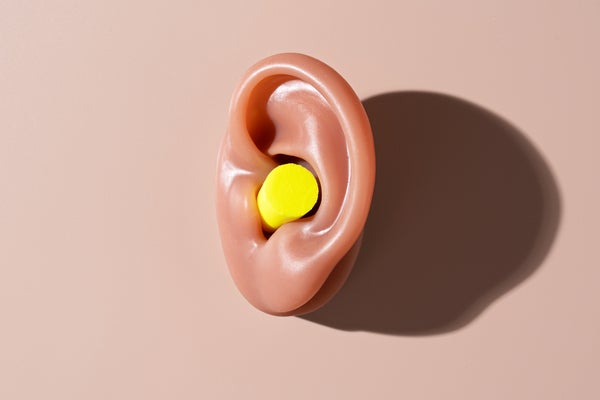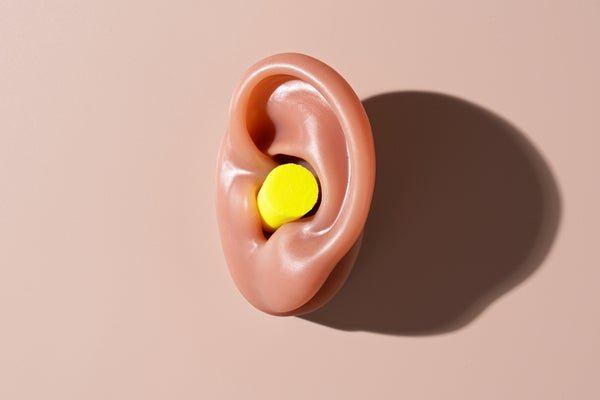New Earplugs Won’t Amplify the Sound of Your Own Voice
Wearing earplugs, hearing aids and earphones can make your own voice sound booming, but a new design dampens the din

Typical earplugs can make the wearer’s own voice sound booming.
If you plug your ears, the voices around you become muffled—while yours becomes annoyingly amplified. “It’s like talking with your head in a barrel. Your own voice sounds booming,” says Kévin Carillo, an engineer who specializes in acoustics and vibration at École de Technologie Supérieure in Montreal.
This “occlusion effect” can make devices such as earplugs and hearing aids uncomfortable, and it sometimes dissuades people from using them at all. Now Carillo and his colleagues have created a 3D-printed earplug that dampens these bothersome internal noises, they reported earlier this month at a meeting of the Acoustical Society of America.
When earplugs, earbuds or hearings aids block, or “occlude,” the outer ear canals, they create closed cavities between themselves and the eardrums. In these cavities, the low-frequency sound waves we routinely make by speaking, chewing and breathing, which propagate through the body’s tissues and bone, will resonate and become amplified before hitting our eardrums.
On supporting science journalism
If you’re enjoying this article, consider supporting our award-winning journalism by subscribing. By purchasing a subscription you are helping to ensure the future of impactful stories about the discoveries and ideas shaping our world today.
Previous solutions to this problem tended to be inefficient, uncomfortable or expensive. Researchers had tried developing ventilated earplugs that allow some air to pass through, custom-made plugs that fit deeper into the ear canal and devices that rely on active electronics to cancel out the low-frequency sound. But Carillo and his colleagues wanted to find a simpler, lower-cost approach. The team 3D-printed tiny interconnected cavities filled with energy-absorbing foam and attached them to a standard earbud-style insert. The low-frequency sound waves in the ear canal enter these cavities and bounce around. By tailoring the cavities’ size and shape, the researchers were able to create a resonant structure that traps and dampens such sound waves instead of amplifying them.
This metamaterial device—which developers are calling the “meta-earplug”—rests in the outer ear like an ordinary earplug. The researchers had previously tested the new design in artificial ears, “but what about the people who need them?” Carillo says. So in his team’s new study, 34 human participants compared several versions of the meta-earplugs with commercial foam ones. Each earplug was equipped with a probe tube that let the researchers monitor sound levels inside the ear canal.
Participants first tried out both types of earplugs in a controlled laboratory environment. They tested the occlusion effect by reading specific texts and making vocal sounds of their own choosing. Then they rated how much low sounds were amplified, how natural their own voice sounded and how isolated they felt from external noises. Finally, they ranked the earplug models based on what they’d prefer to wear while speaking.
In all, 85 percent of the participants preferred the meta-earplugs. Most reported that their low-frequency body noises sounded less amplified and that their own voices sounded more natural to them while they were wearing the new device. Sound-level measurements in the inner ear and just outside the ear canal confirmed these potentially grating sounds were being dampened.
Florian Denk, a researcher at the German Institute of Hearing Aids in Lübeck, says the technique is novel and promising. The microstructural materials allow the earplug to “behave more like the open ear for sounds generated inside the ear canal, making one’s own voice sound much more natural than usual when the ear is occluded,” he says.
Before the meta-earplug can hit the market, the researchers need to optimize its design to ensure it fits all ears comfortably. Additionally, the technology could be used to improve hearing aids, which can also cause the occlusion effect, says Dorothy Neave-DiToro, an associate professor of audiology at the City University of New York Graduate Center. A passive design that’s preferred by most participants “looks very promising,” she says.





